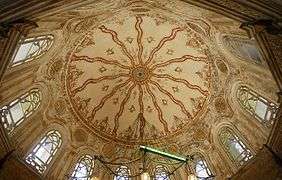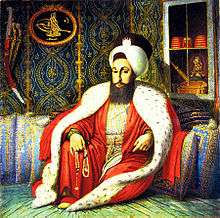Mihrişah Sultan
| Mihrişah Sultan | |
|---|---|
 | |
| Valide Sultan of the Ottoman Empire | |
| Tenure | 7 April 1789 – 16 October 1805 |
| Predecessor | Emine Mihrişah Sultan |
| Successor | Ayşe Seniyeperver Sultan |
| Baş Kadın of the Ottoman Empire | |
| Tenure | 21 July 1764 – 21 January 1774 |
| Predecessor | Aynülhayat Kadınefendi |
| Successor | Ayşe Kadınefendi |
| İkinci Kadın of the Ottoman Empire | |
| Tenure | 1761 – 21 July 1764 |
| Predecessor | Fehmi Kadınefendi |
| Successor | Rif’at Kadınefendi |
| Born |
Agnes c. 1745 Caucasia |
| Died |
16 October 1805 (aged 60) Constantinople, Ottoman Empire |
| Spouse | Mustafa III |
| Issue | Selim III |
| Religion | Islam, previously Eastern Orthodoxy |
Mihrişah Sultan (also spelled Mihr-i Şāh; c. 1745 – 16 October 1805), known as "the Georgian Beauty", was the consort to Ottoman Sultan Mustafa III, and the mother of Sultan Selim III and his de facto co-regent (as the Valide Sultan) for sixteen years from 1789 until 1805.
Of ethnic Georgian origin,[1][2] she was the daughter of a Georgian Orthodox priest.[3][4] Her given name is believed to have been Agnès (Georgian: აგნესა/Agnesa). She was beautiful,[5] and was called "the Georgian Beauty" (Turkish: Gürcü güzeli).[6][7] She received the name Mihr-î-Şah, meaning "Sun of the king".
She is described as a willing protagonist of the reforms of her son's reign. She was especially preoccupied in reforming the military schools and establishing diplomatic corps. She occasionly approached her son to beg a favour or an act of mercy. She founded many schools and mosques in the 1790s. In 1795, she founded the Mihrişah Valide Sultan School and Külliye in the region of Eyüp in Istanbul. In 1805, she ordered the construction of the Mihrişah Valide Sultan Fountain in Yeniköy in İstanbul. The imaret, which was built by the order of Mihrişah, is still in working order. She was the subject of a poem. Mihrişah Valide Sultan and her son Selim III were both members of the Mevlevi Order, which practiced Sufi whirling.
- The türbe of Mihrişah Sultan (exterior view)
 Dome of the mausoleum of Mihrişah Valide Sultan
Dome of the mausoleum of Mihrişah Valide Sultan The son of Mihrişah Valide Sultan, Ottoman Sultan Selim III
The son of Mihrişah Valide Sultan, Ottoman Sultan Selim III
| Styles of Mihrişah | |
|---|---|
| Reference style | Devletli İsmetli Mihrişah Valide Sultan Aliyyetü'ş-şân Hazretleri |
References
- ↑ Gabor Agoston; Bruce Alan Masters (1 January 2009). Encyclopedia of the Ottoman Empire. Infobase Publishing. p. 514. ISBN 978-1-4381-1025-7.
- ↑ E.J. Brill's First Encyclopaedia of Islam 1913-1936. BRILL. 31 December 1987. p. 1117. ISBN 90-04-08265-4.
- ↑ H. Mirgül Eren Griffe (2005). Galip Ali Paşa Rızvanbegovic-Stocevic. Babil. p. 55.
Ortodoks bir Gürcü papazın kızı olan Mihrişah
- ↑ Y. İzzettin Barış (2002). Osmanlı padişahlarının yaşamlarından kesitler, hastalıkları ve ölüm sebepleri. Bilimsel Tıp Yayınevi. p. 184. ISBN 978-975-6986-17-2.
Selim'in annesi olan Mihrişah, Gürcistan'dan kaçırılan bir papazın kızıydı
- ↑ Albert Hourani; Philip Shukry Khoury; Mary Christina Wilson (1 January 1993). The Modern Middle East: A Reader. University of California Press. p. 42. ISBN 978-0-520-08240-3.
beautiful Georgian slave-girl named Mihr-i Şāh
- ↑ Osmanlı tarihi: cilt. Nizam-ı cedid ve Tanzimat devirleri, 1789-1856. Türk Tarih Kurumu Basımevi. 1961. pp. 13, 16.
Gürcü güzeli Mihrişah
- ↑ Osman Horata (1998). Esrâr Dede: hayatı, şiir dünyası ve dı̂vânı. T.C. Kültür Bakanlığı. ISBN 978-975-17-1954-6.
Selim'in Gürcü güzeli ... annesi Mihrişah
| Ottoman royalty | ||
|---|---|---|
| Preceded by Fehmi Kadınefendi |
İkinci Kadınefendi 1761 – 21 July 1764 |
Succeeded by Rif’at Kadınefendi |
| Preceded by Aynülhayat Kadınefendi |
Baş Kadınefendi 21 July 1764 – 21 January 1774 |
Succeeded by Ayşe Kadınefendi |
| Preceded by Emine Mihrişah Sultan |
Valide Sultan 7 April 1789 – 16 October 1805 |
Succeeded by Ayşe Seniyeperver Sultan |